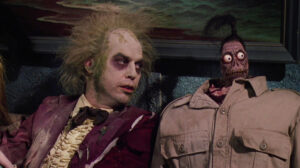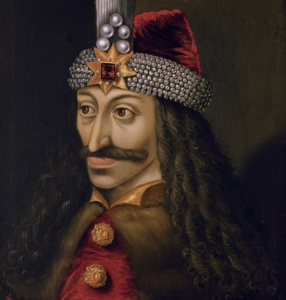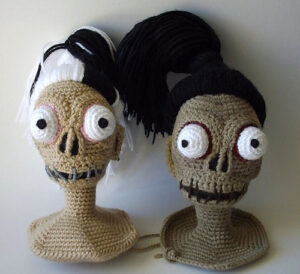THE STRANGE HISTORY OF SHRUNKEN HEADS
#MindOfMarlar is written by Darren Marlar, host of Weird Darkness

Have you ever heard of shrunken heads? You might think they’re just stories from explorers about far-off tribes, plot devices from “Gilligan’s Island”, or a scene from the horror comedy film “Beetlejuice” – but they’re actually quite real. They might be small, but the practice of making shrunken heads has a big history, especially among the Indigenous Jivaro people of Peru and Ecuador.
Imagine a time back in the 19th century when Europeans saw shrunken heads for the first time. They were no doubt horrified at the sight – but, just like drinking black coffee, watching daytime television, or listening to NPR – they eventually acquired a taste for it. Like all human beings, morbid fascination took over – as did their desire to own something so macabre for themselves. Suddenly they wanted to buy tiny human skulls to show off in museums or keep as souvenirs. “Hey, look at my new lucky charm! It’s a shrunken head! Well, it wasn’t so lucky for the guy who lost his head, but look at the luck it has brought me… I now have a tiny human head on a keychain!” And thus began a new trade.

The Jivaroan people lived in the deep forests of the Amazon… which at the time did not have an Amazon.com distribution center, which would have come in handy for selling creepy trinkets to Europeans. The Jivaroans were the original “two heads are better than one” proponents. They had the unique tradition of shrinking the heads of their enemies… not in a psychiatrist’s office by asking, “How did you get along with your mother?” – not that kind of head shrink – but literally diminishing the size of actual human heads. It wasn’t just a gruesome hobby either; it was a way to protect themselves from vengeful spirits. The Jivaro believed that if they didn’t shrink the heads of their enemies, the spirits of those they killed would come back to haunt them. Honestly though, if you killed me, cut off my head, and then shrunk it – wouldn’t that just give me more incentive to come back and seek ghostly vengeance upon you? Well, yes – but the Jivaro believed the shrunken heads (which they called “tsantsas”) trapped the spirits inside. Like a gruesome form of a genie being corked in a bottle, perhaps – but don’t expect to rub its cheeks and release a bikini-clad Barbara Eden eager to grant your every wish. You’d be releasing a raging lunatic who would be so angry he’d lose his head… because he lost his head.

Aside from spiritual reasons, the Jivaro also made shrunken heads as a warning to other tribes not to mess with them. I’m sure it was effective. Imagine walking towards a village with tiny human heads being hung from poles and tree branches as you got nearer… you’d do everything in your power not to offend those folks. Even Vlad the Impaler would’ve thought, “Wow… seriously? That’s just going too far, dudes.”
If human heads were unavailable (like maybe it was a slow hunting day, or they had not yet renewed their “beheading license” for the season), they would use the heads of animals like sloths… which kinda seems unsporting, doesn’t it? How hard would it be to hunt down and kill a sloth? Striking down your enemies and shrinking their heads makes sense if you want to terrify people – but killing a sloth? That just makes you a lazy hunter. Now… go kill a hippopotamus and shrink that head, then you’ve got my respect. Seriously. Hippos kill more people than sharks each year. And can you imagine that head on a keychain!?
Regardless of the species though, creating a shrunken head was a meticulous process. It involved removing the skin from the skull, boiling it, and then shrinking it with hot stones and sand on the inside. The finished head was hung over a fire to harden, and the resulting soup was used in gravy and served on “Mystery Meat Monday” in Jivaro high school cafeterias. I’m assuming.
When Europeans discovered these shrunken heads, they became highly sought after. The Jivaro made it big-business and traded them for goods like guns and knives. And what did getting guns and knives do for the Jivaro people? Yep – it made it easier to hunt down and collect more heads for shrinking! It was a win-win-lose for everybody! (You gotta love that entrepreneurial spirit!) Eventually, the trade in shrunken heads became so big that hunting your enemy’s men wasn’t enough – and the tribes began hunting women and children too. Apparently that finally got someone’s attention in South America and they starting thinking, “Hey – you know, this killing people to cut off their heads to shrink and sell probably isn’t a very nice thing to do. Somebody might get hurt! Maybe we should tell people to stop doing it!” In the 1930s buying shrunken heads was finally outlawed in South America.

But still, there were many heads out there that were already sold, on the market, in museums, and in private collections, and were displayed as evidence of the “primitive” Amazon people. But in recent years, there has been a push to return these heads to their rightful place. To the Amazon, that is – it’s doubtful the true “rightful” place – back on top of the shoulders of their beheaded victims – will ever become a reality. Not to mention they wouldn’t fit anyway.
Today, the practice of making shrunken heads has largely disappeared, aside from artists who make fake ones just for the morbid buyers who want something so grotesque. But the legacy of the trade lives on in reality as well: black market dealers still try to sell the genuine article. It’s a constant reminder of a dark practice in history that even in our modern world is hard to get ahead of. (Sorry, couldn’t resist.)
(SOURCE)
Views: 33

